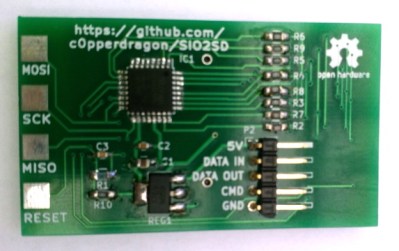There’s plenty of fun to be had with retrocomputers of yesteryear, but for modern users, it can be something of a culture shock. Going back to floppy disks after all these years is a reminder of just how far storage technology has come in terms of speed, reliability, and of course, capacity. Luckily, there are ways to combine the best of both worlds.
Floppy drive emulators for classic computers are of course nothing new, but we think this one [c0pperdragon] has put together is worthy of a closer look. Not only does the ATmega32U4 based emulator have an exceptionally low part count, but the code has been written in the Arduino IDE. Both features make it easy for new players to duplicate and revise the design should they feel so inclined. In a pinch you could even implement it on a breadboard with a garden variety Arduino.
 The emulator is housed in a 3D printed enclosure designed to look like an era-appropriate Atari 1050 Disk Drive, except you’re using SD cards instead of floppies. The firmware can mimic two physical drives and supports up to 100 disk images on each SD card. The user interface is about as simple as it gets, with two push buttons and a pair of seven-segment LEDs to indicate which disk image is currently loaded up.
The emulator is housed in a 3D printed enclosure designed to look like an era-appropriate Atari 1050 Disk Drive, except you’re using SD cards instead of floppies. The firmware can mimic two physical drives and supports up to 100 disk images on each SD card. The user interface is about as simple as it gets, with two push buttons and a pair of seven-segment LEDs to indicate which disk image is currently loaded up.
We’ve seen some very elaborate disk emulators over the years, but there’s something compelling about how straightforward this version is. If it helps a few more people experience the unique joys of retrocomputing, it’s a win in our book.
















Awww… isn’t it just precious… The 1050 drive: “I call it mini-me”
Interesting… got a feeling I could bodge something for the CoCo-2 I’ve had sitting around with it.
That looks to be a lot easier to deal with than building an SIO2PC cable, which was kind of a pain in the tuckus to do, and in this day and age requires an older PC with an actual serial port… :)
Actually my gaming/retro computer workstation has serial on its z390 motherboard. I’m not using it since I have a cheap PCIe to serial card installed from my previous build and it gets exclusively used for apple IIc disk copying via adtpro. It’s kinda odd for a gaming motherboard to have serial, though.
CoCo-2 hmm I think
http://cocosdc.blogspot.com/
Might be it?
My previous comment was deleted. Why so rude when it is your mistake?
Let me say this again:
>Not only does the ATmega32U4 based emulator
The schematic in doc directory shows ATMega328. There is no U, nor USB connection.
Maybe it’s because you aren’t reading the project page? The creator says he’s using the U4 so he can get debug info, but it’s optional.
The author specifically mentions that this can run on a 32U4.
What ATmega you choose probably comes down to personal preference or what’s in the parts box.
As it’s Arduino IDE based there would be a range of options. Even less common chips like the 1284 if you don’t mind editing the hardware files.